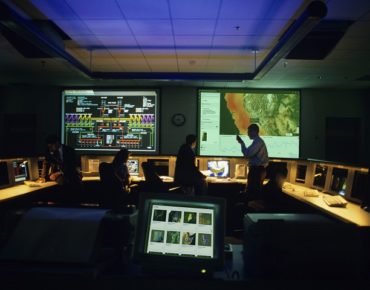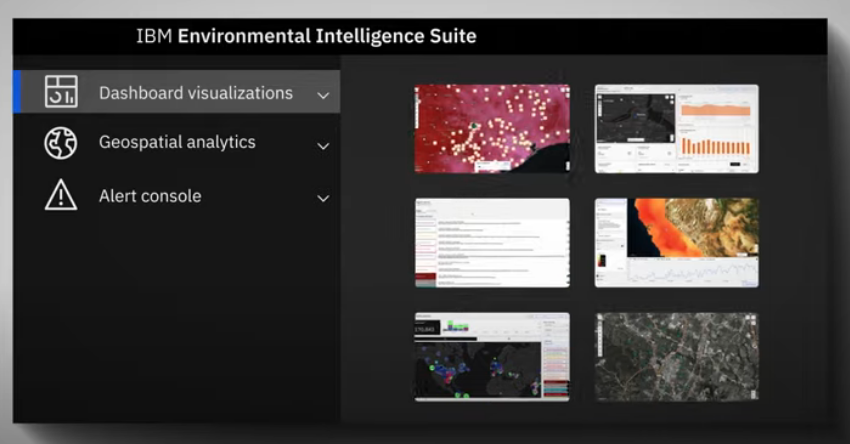IBM Integrating AI to Help Enterprises See and Monitor Weather and Climate Impacts and Risks

As destructive global warming trends continue to dramatically affect businesses around the world, IBM is bringing together AI data, weather data and climate risk analytics to give enterprises hardier tools to prepare for and respond to changing environmental conditions that affect them.
With its new IBM Environmental Intelligence Suite, which was announced by the company Oct. 12 (Tuesday), IBM is using AI to give enterprises new capabilities to monitor and deal with extreme weather and related issues that affect supply chains, manufacturing and more, while also helping companies to report such problems as part of regulatory compliance requirements.
The SaaS-based IBM Environmental Intelligence Suite gives organizations the tools they need to monitor and send alerts for disruptive environmental conditions such as severe weather, wildfires, flooding and poor air quality, while also predicting potential impacts of climate change and weather problems for businesses. The suite also allows businesses to gain insights into potential operational disruptions, while prioritizing and conducting mitigation and response efforts.
The suite is aimed at large companies that are required to file compliance and regulatory reports about environmental, social and governance (ESG) factors that must be included in their annual reports, Joe Berti, the vice president of IBM AI applications, told EnterpriseAI.
“IBM is an advisor to the top companies on the planet, so their CEOs were pinging our CEO, Arvind Krishna, asking how he was dealing with our ESG reporting,” said Berti. “Investors are putting more and more pressure to [corporate executives to] say, ‘OK, what are your climate initiatives going forward?’”
With those inquiries and demands, the IBM Environmental Intelligence Suite was born, said Berti.
That task was made easier for the company because IBM had acquired The Weather Co. five years ago, which provides a rich weather data library and meteorological expertise, while it already has rich AI tools and IBM’s existing geospatial database to bring it all together, he said.
The tools in the new suite can help enterprises analyze how retailers can better prepare for severe weather-related shipping and inventory disruptions, or to analyze the potential environmental risks of future warehouse locations, according to IBM. The tools can also help power and utility companies to determine where to trim trees around electrical lines to protect against power disruptions from falling branches and where to remove combustible ground cover to prevent wildfires, while also helping them to balance supply and demand for renewable energy. In addition, the suite could allow supermarket chains to visualize the effects of their food refrigeration systems in their grocery stores so they can review how they are contributing to their overall greenhouse gas emissions and create strategies for making improvements as needed.
Enterprises can get these kinds of environmental insights from the suite through APIs, dashboards, maps and alerts that can address immediate operational challenges and long-term planning as well.
The suite incorporates AI-driven innovations from IBM Research to allow climate and data scientists to analyze massive environmental datasets, along with a new climate risk modeling framework, according to IBM. Also included are IBM Research tools that apply natural language processing and automation capabilities to help companies estimate carbon emissions, while identifying opportunities to reduce them across their operations or with suppliers.
 These analyses will be even more critical for a wide range of businesses which need to understand how climate will affect their operations in the next five to 15 years, said Berti.
These analyses will be even more critical for a wide range of businesses which need to understand how climate will affect their operations in the next five to 15 years, said Berti.
“Imagine being a bank and having $100 billion in loans,” said Berti. “You have to analyze that portfolio to determine the climate risk associated with it as well. The number of use cases that we are seeing does not seem to have a limit.”
Those analyses get incredibly granular, he said, such as using data science to look at tree growth rings in forests so that power utilities can gather information to plan tree trimming that can prevent devastating wildfires that left unchecked can destroy whole communities, he said.
The new suite uses natural language processing and algorithms that evaluate past weather data so that predictions can be made for how weather systems will behave in the future, said Berti.
“AI [in the suite] can be used in agriculture, where it can determine rainfall and winds associated with crops as well,” said Berti. “There are more and more disruptions in supply chain with food and other related events.”
The work on the suite began more than 18 months ago, said Berti.
“Arvind wanted to spend more of IBM’s time on climate and helping companies with climate-related [concerns],” said Berti. The team started with an IBM product called the Weather Operations Center and added components from IBM Research, including its geospatial database and a carbon accounting engine that was being built, said Berti. Those tools were then embedded into the IBM Environmental Intelligence Suite, which was then launched as a new product.
 Enterprises can use the suite via connectors to applications from IBM, SAP and others to import their data and run it in the suite, he said.
Enterprises can use the suite via connectors to applications from IBM, SAP and others to import their data and run it in the suite, he said.
“What makes IBM unique with this is that it is the combination of weather, climate and data science,” said Berti. “Nobody else has a weather business laying around. It is not an easy thing to even replicate, and the data science tools are billions of dollars of investment. IBM is in a unique spot, and we are claiming a new category – environmental intelligence – that will live on for the next 15-20 years. Just like supply chain intelligence or others are new categories, we are defining a new space.”
Bjoern Stengel, an analyst with IDC, told EnterpriseAI that the new IBM suite could be a useful tool for enterprises as they deal with the constantly-changing demands of climate change, supply chain challenges, regulations and more.
“I think it is innovative insofar as it takes an outside-in view on the impact of environmental factors on enterprises’ operations,” said Stengel. “Most solutions I have seen announced lately take more of an inside-out view – capturing, reporting and assessing operational data for ESG-related impacts. So, instead of focusing on how an enterprise’s operations affect the environment and reporting that information to different stakeholders such as investors, the Environmental Intelligence Suite helps them respond to changing environmental conditions and factor that into their operational decision-making.”
For enterprises, these kinds of tools can directly help them make decisions that improve operational efficiency, avoid interruptions and address changing customer demands, said Stengel. “It is interesting to see how IBM leverages certain capabilities and assets that they have developed/acquired over the past years – through the acquisition of the Weather Company and technologies such as AI.”
Stengel said he still would like to see more about how it all might be merged with the inside-out view that IBM could technically provide. “This would give enterprises almost a circular information flow of capturing and reporting environmental information,” he added.












